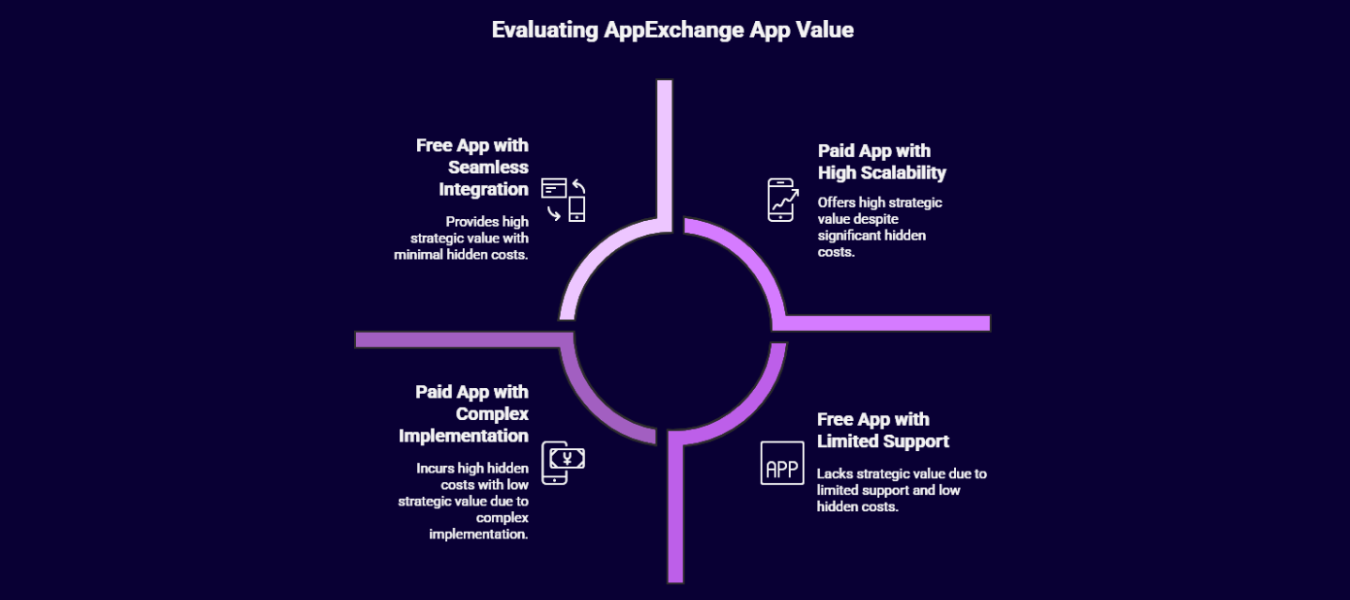
The allure of “free” is powerful, especially when it comes to enhancing your Salesforce ecosystem with AppExchange apps. The promise of added functionality without an upfront cost can seem like an irresistible offer. However, at Xccelerance Technologies, we believe in looking beyond the surface. The reality is that “free” AppExchange apps often come with a range of hidden costs that can impact your business in unexpected ways. Understanding these potential expenses and learning how to evaluate the true value of any app, free or paid, is crucial for making strategic decisions that benefit your organization in the long run.
Beyond the Zero-Dollar Price Tag: Uncovering Hidden Costs
While the initial download of a free AppExchange app might not dent your budget, several indirect costs can accumulate over time. It’s essential to consider these before integrating any new solution into your Salesforce environment.
- Implementation and Configuration Time: “Free” doesn’t mean effortless. Even seemingly simple apps require time and resources for installation, setup, and configuration to align with your specific business processes. This often involves pulling valuable team members away from their core responsibilities. The complexity of this setup can vary significantly, and what appears straightforward initially can quickly become a time-consuming endeavor.
- Customization and Integration Challenges: Out-of-the-box free apps may not perfectly fit your unique operational needs. Customization, if even possible, can require development resources, adding unforeseen expenses. Furthermore, ensuring seamless integration with your existing Salesforce setup and other third-party tools can be a significant hurdle. Poor integration can lead to data silos, inefficiencies, and a fragmented user experience. Sometimes, to make a “free” app truly functional within your specific environment, you might need to invest in additional tools or services.
- Limited Support and Maintenance: Vendors of free apps typically offer limited or community-based support. When issues arise, or your team needs assistance, a lack of dedicated support can lead to prolonged downtime and frustration. Regular updates and maintenance to ensure compatibility with Salesforce’s seasonal releases or to address bugs might also be inconsistent or non-existent for free apps. This can leave your organization vulnerable or stuck with an outdated, inefficient tool.
- Scalability Constraints: A free app that works well for a small team or a limited dataset may struggle as your business grows and your data volumes increase. Scalability is a critical factor, and free solutions often lack the robust architecture to handle expanding requirements. This can force a disruptive and costly migration to a more capable, often paid, solution down the line.
- Security Vulnerabilities: While all apps on the AppExchange undergo a security review, the level of ongoing security scrutiny and updates might differ between free and paid apps. It’s crucial to understand that even free apps must pass this review. However, the onus of ensuring an app, particularly an unmanaged package, doesn’t introduce vulnerabilities into your Salesforce org largely falls on you. Data security is paramount, and any compromise can lead to significant financial and reputational damage. Some free apps might require extensive permissions that could pose a security risk if not carefully evaluated.
- Training and User Adoption: Any new tool requires users to learn how to use it effectively. While some apps are intuitive, others may necessitate formal or informal training sessions. The time spent on training, and the potential dip in productivity during the learning curve, represents an indirect cost. Poor user adoption due to a complex interface or lack of perceived value can render even a “free” app useless.
- Opportunity Cost: Time spent grappling with a sub-optimal free app is time that could have been invested in more strategic initiatives or a more robust, value-driven solution. The cumulative effect of workarounds, troubleshooting, and inefficiencies associated with a “free” tool can outweigh the perceived initial savings.
- Impact on Org Limits: While managed packages that pass security review generally don’t count against certain org limits like custom tabs and objects, unmanaged packages and the resources they consume always do. It’s important to be aware of how an app, even a free one, might impact your Salesforce org’s limitations on data storage, API calls, and more.
Evaluating True Value: A Strategic Approach
Moving beyond the sticker price requires a holistic evaluation process. Whether an app is free or paid, the goal is to determine its true value to your organization.
- Define Your Business Requirements Clearly: Before browsing the AppExchange, articulate the specific problems you’re trying to solve or the enhancements you need. Well-defined requirements will serve as your primary filter and prevent you from being swayed by features you don’t need.
- Calculate the Total Cost of Ownership (TCO): TCO extends beyond the purchase price (which is zero for free apps) to include all associated costs over the app’s lifespan. This encompasses implementation, customization, integration, training, support, maintenance, and potential upgrade costs. For “free” apps, the TCO is entirely composed of these indirect, yet significant, expenses.
- Scrutinize Vendor Reputation and Support: Investigate the app provider. Look at their history, the frequency of updates, and the quality of their documentation. For paid apps, and even for some free ones, assess the available support channels and responsiveness. User reviews and ratings on the AppExchange can offer valuable insights into real-world performance and support experiences.
- Prioritize Security and Compliance: Thoroughly vet the app’s security posture. Understand its data access requirements and how it handles sensitive information. Ensure it complies with relevant industry regulations. Don’t hesitate to ask vendors direct questions about their security practices. Salesforce itself mandates a security review for all listed apps, but ongoing vigilance is key.
- Assess Scalability and Future-Proofing: Consider your organization’s growth trajectory. Will the app be able to handle increased users, data volume, and evolving business processes? Opting for a slightly more expensive app that can scale might be more cost-effective in the long run than repeatedly replacing free tools.
- Leverage Free Trials and Demos: Most paid apps offer free trial periods or demos, and even many free apps can be tested in a sandbox environment. Take full advantage of these opportunities to assess functionality, ease of use, and compatibility with your Salesforce instance before committing. Test with real-world scenarios and involve end-users in the evaluation process.
- Evaluate Integration Capabilities: Ensure the app integrates smoothly with your existing Salesforce environment and any other critical business systems. Seamless integration is key to maximizing efficiency and data accuracy.
- Quantify the Return on Investment (ROI): For any app, free or paid, try to quantify the expected benefits. This could be in terms of time saved, increased productivity, improved data quality, enhanced customer satisfaction, or new revenue opportunities. While direct financial ROI might be harder to pinpoint for some utility apps, the efficiency gains and risk mitigation can be substantial. Some vendors or resources may even offer ROI calculators to help with this assessment.
- Consider Native vs. Off-Platform Solutions: Native Salesforce apps are built directly on the Salesforce platform. This can offer advantages in terms of security, TCO, and seamless integration, as they often share Salesforce’s underlying security architecture and don’t require data to be transferred outside the platform.
The Xccelerance Perspective: Investing in Value, Not Just Savings
At Xccelerance Technologies, we advocate for a value-driven approach to technology adoption. While “free” can be a tempting starting point, a thorough evaluation often reveals that the true cost of an app extends far beyond its initial price tag. By looking at the complete picture – including implementation effort, potential customization needs, support availability, scalability, security implications, and the overall TCO – businesses can make informed decisions that drive genuine, sustainable value.
The AppExchange is a powerful resource for extending Salesforce capabilities. However, navigating it successfully requires a strategic mindset that prioritizes long-term benefits and operational excellence over short-term, superficial savings. Don’t let the allure of “free” obscure the potential for hidden costs. Instead, focus on identifying solutions that truly empower your organization and deliver a demonstrable return on your most valuable asset: your time and resources.


